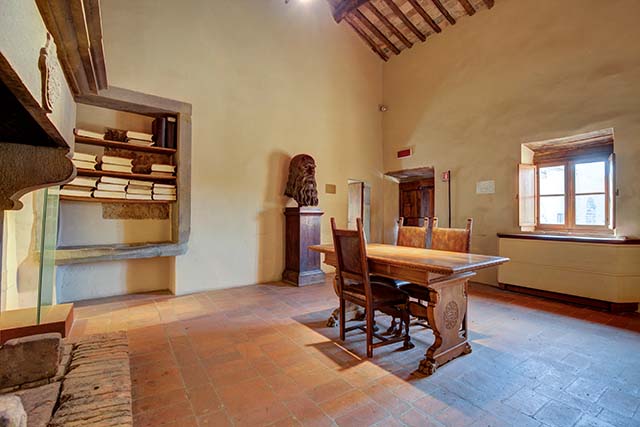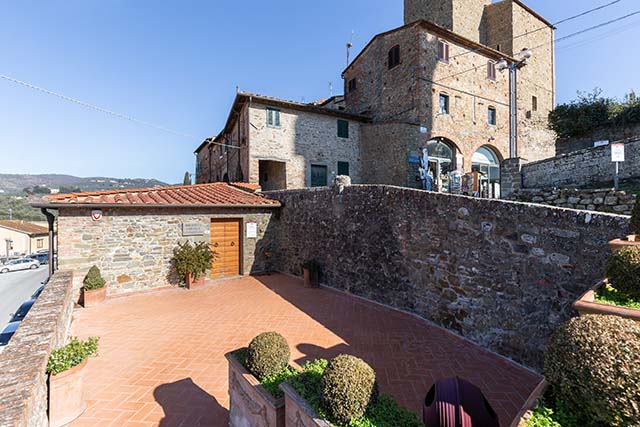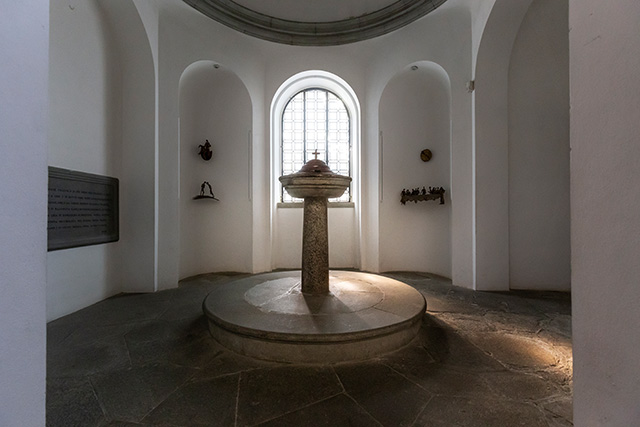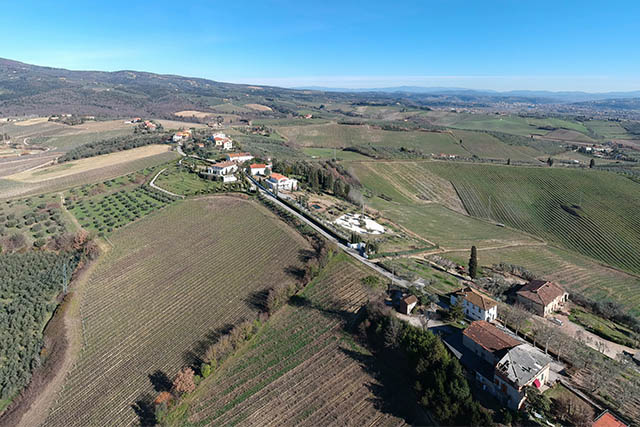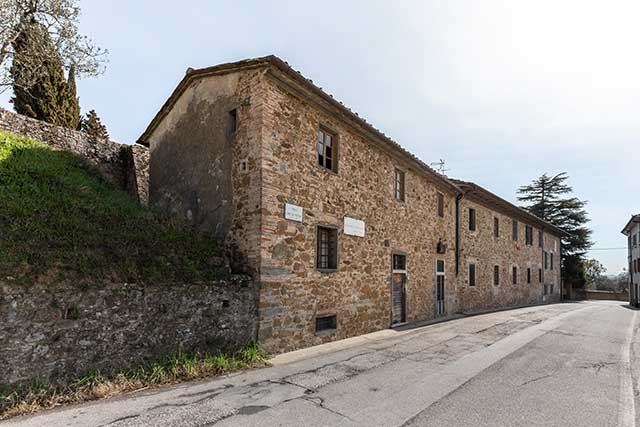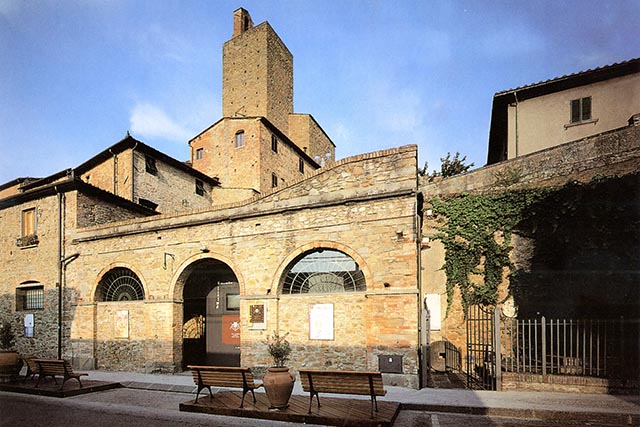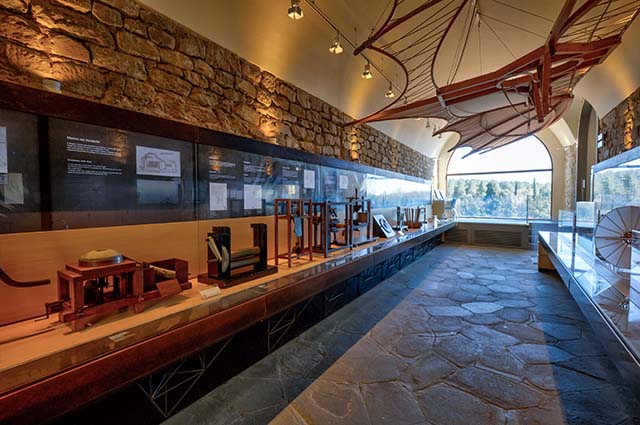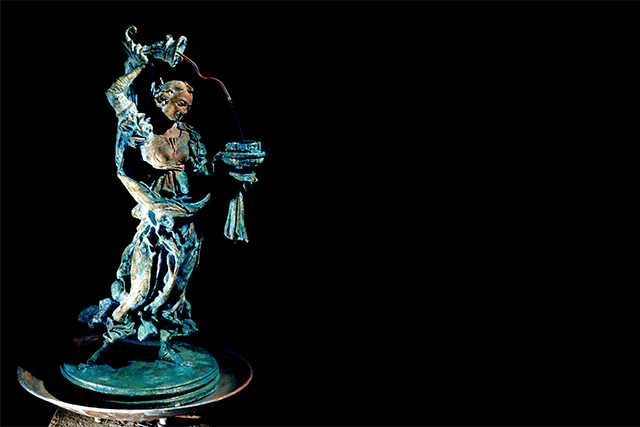Municipality of Vinci
The house at Anchiano entered into the patrimony of the da Vinci family around 1480, and perhaps Ser Piero, Leonardo's father, was thinking of making it into a resting place along the road rising from Vinci up to the passes of Montalbano. After Ser Piero's death, the complex was still composed of “una casa da oste principiata” (an innkeeper’s house, just begun). Successively, the branch of the family of Gugliemo da Vinci, one of Leonardo's half-brothers, took root in Anchiano. The series of studies during the last century on the theme of Leonardo’s birth gave rise to the extraordinary 'place of memory' that today is the Casa Natale di Leonardo (Leonardo’s birth house) in Anchiano, enriched by technological solutions allowing you as a visitor to immerse yourself, together with Leonardo, in his life story.
The Biblioteca Leonardiana is today one of the leading institutions for Leonardo da Vinci specialists and enthusiasts, as well as leading promoter of sector studies and scientific dissemination, such as with the conference cycle of the Letture Vinciane. The library is situated at the upper part of Vinci, the castle, conserving more than 13,000 items in its collections, including works about Leonardo and by Leonardo himself. The library offers an extraordinary instrument for learning about the Leonardo manuscripts, referred to as e-Leo, a database making it possible to consult the complete works of Leonardo in high-resolution digital format, enhanced also by specially designed research apparatus.
The castle of Vinci is one of the best preserved of the Guidi fortresses in the Lower Valdarno. The history of its origins coincides with that of the powerful noble family, rooted in partibus Greti since the end of the 11th century. Leonardo, who was certainly baptized in the church of Santa Croce, was raised by his father's family, who lived in the village of the castle. The houses of the da Vinci family have been identified in the building at the corner between the current Via Roma and Piazzetta Guazzesi. Today the castle houses the spaces of the Museo Leonardiano and a rich series of 'Vincian places', through which we can retrace some of the moments of his life, and the appeals of the suggestiveness of some of his works.
Santa Croce was the parish church of notary ser Piero da Vinci’s family. It was here that his son Leonardo, not legitimate, but firstborn, was baptized in April 1452. Of the church frequented by the da Vinci family, nothing remains but the title: the current building, in fact, is the result of the radical reconstruction of the ancient Vinci church that originally belonged to the Counts Guidi. Preserved inside, however, is the ancient baptismal font where the baptismal ceremony for the newly born Leonardo took place. In the community of Santa Croce, Leonardo’s family had several farms, of which traces remain today in the names of some of the farmhouses dotting the Vinci hills.
Collegonzi, one of the ancient castles that the Counts Guidi owned in the area of Greti, must have appeared in the time of Leonardo as an open village, a cluster of houses at that point lacking in ancient fortifications. It was in this form, in fact, that it was drawn by Leonardo in the famous bird's eye view map from the Windsor Castle collection. Leonardo knew Collegonzi well; he described the famous “cut bank,” a part of the right bank of the Arno affected by the erosive action of the flow of water, based on which Leonardo had matured his observations about the origin of the "nichi", the marine fossils present in large quantities in the Pliocene levels of the Collegonzi hills.
Carlo Pedretti earned an international reputation as one of the greatest experts on Leonardo da Vinci of the 20th century. He established a cultural foundation in Lamporecchio, whose seat is located in the villa that once was his private residence. In the nearby village of Vinci the foundation has also recently opened a cultural and exhibition centre, the Villa Baronti-Pezzatini. The mission of the Pedretti Foundation is to conserve for posterity the scholarly work that was conducted by Prof. Pedretti and to promote and sponsor continuing research in the areas that he pioneered.
The Leonardian project of an artificial lake that was to be created just below the castle of Vinci is to be considered the only work Leonardo designed for his native land. Leonardo’s idea, represented on three different maps, provided for the creation of a basin fed by the waters of three brooks that descended from Montalbano, blocked off downstream by a barrage. The watercourses involved in this project, which we can recognize perfectly, had long been defended by the municipal authorities. It may have been a public project, probably related to the use of the mechanical force of water for driving the water wheels of the mills that dotted the valleys of the lands of Leonardo.
What distinguishes the figure of Leonardo as a man of science is surely the outstanding empirical character of his knowledge. One of his papers linking him to the years of his early youthful experience in Vinci is one on which he explicitly mentions the Mill of La Doccia di Vinci, alongside sketches of mechanisms for a water wheel. The place where the ancient mill mentioned by Leonardo stood still exists along the road that goes up from Vinci to Anchiano. A little further upstream is the well-preserved weir of the mill, in masonry terraced with steps, which recalls constructed items of the same type drawn by Leonardo.
The square that, with Leonardo's starry dodecahedron, today welcomes visitors ascending to the castle is an invitation to enjoy the entire program of knowledge dedicated to Leonardo offered by the two venues of the Museo Leonardiano. The entrance of the new headquarters, Palazzina Uzzielli, coincides with the new Piazza Guidi, the work of contemporary artist Mimmo Paladino. Paladino’s symbols inspired by Renaissance geometry merge with the backdrops of Leonardo's landscapes, in an original and evocative contemporary urban space.
In the heart of Vinci a unique museum was founded in the 1990s, the first to be dedicated to this figure in all of his complexity. The Museo Ideale has earned official recognition as an institution of great public benefit by the regional government of Tuscany. To mark the fifth centenary of the death of Leonardo, the museum has been completely refurbished; its permanent exhibitions have been renovated and a special exhibition of works of particular importance and value is on display.
In the heart of Vinci, at the Palazzina Uzielli and the Castle of the Counts Guidi, the Museo Leonardiano houses the oldest collection of models of Leonardo’s works as scientist and engineer, consisting of more than 80 wooden reproductions and digital animations. A center for study and documentation, together with the Biblioteca Leonardiana, the Museo Leonardiano pursues research on Leonardo's technical and scientific work within the context of Renaissance culture, in significant collaborations with national and international university and research institutes.
The vastness of Leonardo's interests and studies—from construction site machinery to futuristic devices for textile manufacturing, from projects for war technology to those allowing humans to soar in flight, or to move about, above or below the water, and on to experiments in optics and anatomical studies—these are all fully documented in the Museum.
Leonardo da Vinci took a great interest in agriculture, and recorded observations on agricultural techniques in his notebooks, complete with sketches of farming tools and olive presses. Since Leonardo himself owned some vineyards, he made many notes on the cultivation of grape vines and enology. To document this particular aspect of his activities, the Museo Ideale Leonardo Da Vinci has created a separate section, “The Renaissance of Wine”, housed in a beautiful 16th-century villa in Sant’Ippolito in Valle, not far from the main museum located in Vinci.
The ancient community of San Bartolomeo a Streda was situated, from the origins, on the border between the territories of Cerreto and Vinci. On the slopes of the gentle hills on which the church of San Bartolomeo lies today, well preserved in the aspect that it must have had, roughly, in the times of Leonardo, the da Vinci family owned its most productive vineyards. In the list of properties declared by Leonardo's father in 1469, was the podere della chosta (Chosta farm), with an overall value of 1000 florins, and which, according to what was declared, yielded 40 barrels of wine per year.
The geological area that, during Leonardo’s time, also included the community of San Donato in Greti, the ancient district of one of the churches belonging to the Counts Guidi in the 13th century, is characterized by clays and Pliocene levels, rich in fossils of marine origin. It is located near Collegonzi, where Leonardo observed the famous "nichi" (fossil shells) of the sea. At the time of Leonardo, there were several furnaces in this area for the production of bricks, such as that in the locality of Mercatale, where Leonardo's stepfather, the renowned Accattabriga, also worked.
The church of San Lorenzo in Arniano belonged in the middle of the 13th century to the powerful family of the Counts Guidi. It was located on one of the hills of the Montalbano slope facing the Val di Streda, and today there remains an ephemeral trace in the structures of a ruined farmhouse along a local road that still bears the name of San Lorenzo. Leonardo knew these places very well, as his family owned lands and estates in the area. The waterways of the community of San Lorenzo in Arniano were depicted with great precision by Leonardo, who had projected the construction, downstream, of an artificial lake.
At Campo Zeppi, where today there is a group of farmhouses, lived Caterina, Leonardo's mother, together with the family of the man she married, originally from San Pantaleo, known at the time as l’Attaccabriga (the quarrel seeker). These places, very ancient in origin, seem crystallized in the landscape of those times: the church of San Pantaleo was the parish church of Caterina, as well as of the other inhabitants of the houses of Campo Zeppi, and the vineyards are the same ones that Leonardo could see when he went to visit his mother. Among the plots of terrain of the San Pantaleo vineyards, Leonardo could have observed the particular geological formations rich in fossils of marine origin, which he referred to as "nichi” (fossil shells).
The rural parish church of Sant'Ansano is one of the topographic landmarks that Leonardo reported, accompanied by the toponym santosano, on the famous bird's eye view map of Montalbano conserved in the Windsor Castle Collection (RLW 12685). The origins of the parish church, one of the oldest in the diocese of Pistoia, date back to the 10th century, but the church that Leonardo viewed must have corresponded roughly to the Romanesque building we can see today, even after the post-World War II restorations. Inside we can admire the series of figured capitals decorating the columns of the central nave and the marble baptismal font attributed to Baccio da Montelupo.
The ancient community of Santa Lucia a Paterno included, during Leonardo’s time, the hamlet of Anchiano, the place where the farm house stands today that tradition recognizes as Leonardo's birthplace. The church of Santa Lucia, which is conserved in 18th-century forms, has absorbed this Leonardian memory from the beginning of the last century, transmitted through a plaque that recalls it as the church where Leonardo was baptized, an event that actually occurred at the church of the Santa Croce in Vinci. However, the church of Paterno was the parish of the family branch of one of Leonardo's half-brothers, Guglielmo di ser Piero da Vinci, who requested, in his will, to be buried in the small church of Santa Lucia.





